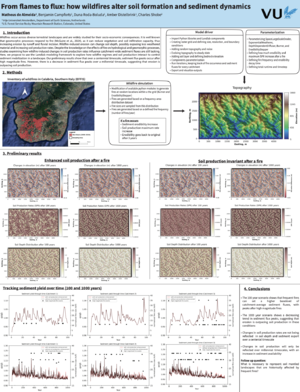2025 CSDMS meeting-037: Difference between revisions
From CSDMS
No edit summary |
No edit summary |
||
| (2 intermediate revisions by one other user not shown) | |||
| Line 2: | Line 2: | ||
|CSDMS meeting first name=Matheus | |CSDMS meeting first name=Matheus | ||
|CSDMS meeting last name=Wanderley de Almeida | |CSDMS meeting last name=Wanderley de Almeida | ||
|CSDMS Pronouns= | |CSDMS Pronouns=he/him | ||
|CSDMS meeting institute=Vrije Universiteit Amsterdam | |CSDMS meeting institute=Vrije Universiteit Amsterdam | ||
|CSDMS meeting city=Amsterdam | |CSDMS meeting city=Amsterdam | ||
| Line 10: | Line 10: | ||
}} | }} | ||
{{CSDMS meeting select clinics1 2025 | {{CSDMS meeting select clinics1 2025 | ||
|CSDMS_meeting_select_clinics1_2025= | |CSDMS_meeting_select_clinics1_2025=4) Get lazy with LLMs | ||
}} | }} | ||
{{CSDMS meeting select clinics2 2025 | {{CSDMS meeting select clinics2 2025 | ||
|CSDMS_meeting_select_clinics2_2025= | |CSDMS_meeting_select_clinics2_2025=3) The Finite Element Method (FEM) | ||
}} | }} | ||
{{CSDMS meeting select clinics3 2025 | {{CSDMS meeting select clinics3 2025 | ||
| Line 19: | Line 19: | ||
}} | }} | ||
{{CSDMS meeting abstract yes no 2025 | {{CSDMS meeting abstract yes no 2025 | ||
|CSDMS meeting abstract submit 2025= | |CSDMS meeting abstract submit 2025=Yes | ||
}} | |||
{{CSDMS meeting abstract poster Epub 2025 | |||
|CSDMS meeting poster Epub submit 2025=Poster | |||
}} | |||
{{CSDMS meeting abstract title temp2025 | |||
|CSDMS meeting abstract title=From flames to flux: how wildfires alter soil formation and sediment dynamics | |||
|Working_group_member_WG_FRG=Terrestrial Working Group | |||
}} | |||
{{CSDMS meeting authors template | |||
|CSDMS meeting coauthor first name abstract=Benjamin | |||
|CSDMS meeting coauthor last name abstract=Campforts | |||
|CSDMS meeting coauthor institute / Organization=Vrije Universiteit | |||
|CSDMS meeting coauthor town-city=Amsterdam | |||
|CSDMS meeting coauthor country=Netherlands | |||
|CSDMS meeting coauthor email address=b.campforts@vu.nl | |||
}} | |||
{{CSDMS meeting authors template | |||
|CSDMS meeting coauthor first name abstract=Duna | |||
|CSDMS meeting coauthor last name abstract=Roda-Boluda | |||
|CSDMS meeting coauthor institute / Organization=Vrije Universiteit | |||
|CSDMS meeting coauthor town-city=Amsterdam | |||
|CSDMS meeting coauthor country=Netherlands | |||
|CSDMS meeting coauthor email address=d.c.rodaboluda@vu.nl | |||
}} | |||
{{CSDMS meeting authors template | |||
|CSDMS meeting coauthor first name abstract=Amber | |||
|CSDMS meeting coauthor last name abstract=Distelbrink | |||
|CSDMS meeting coauthor institute / Organization=Vrije Universiteit | |||
|CSDMS meeting coauthor town-city=Amsterdam | |||
|CSDMS meeting coauthor country=Netherlands | |||
|CSDMS meeting coauthor email address=a.distelbrink@vu.nl | |||
}} | |||
{{CSDMS meeting authors template | |||
|CSDMS meeting coauthor first name abstract=Charles | |||
|CSDMS meeting coauthor last name abstract=Shobe | |||
|CSDMS meeting coauthor institute / Organization=U.S. Forest Service Rocky Mountain Research Station Fort Collins | |||
|CSDMS meeting coauthor town-city=Colorado | |||
|CSDMS meeting coauthor country=United States | |||
|CSDMS meeting coauthor email address=charles.shobe@usda.gov | |||
}} | |||
{{CSDMS meeting abstract template 2025 | |||
|CSDMS meeting abstract=Wildfires occur across diverse terrestrial landscapes and are widely studied for their socio-economic consequences. However, their role in triggering erosion and controlling sediment dynamics is less well understood. Wildfires reduce canopy and ground cover, disrupting soil infiltration capacity, thus increasing erosion by runoff and channel incision. Wildfire-induced erosion can change soil depth, possibly exposing less weathered material and increasing soil production rates. Despite extensive research into the effects of fire on hydrological and geomorphic processes, studies examining how wildfire-induced changes in soil production rates influence catchment-wide sediment fluxes are still lacking. Here, we propose to use the Landlab modeling framework to explore how wildfire regimes and soil production interact to control sediment mobilization in a landscape. Pulses of sediment can be triggered after a single fire, however, in areas with frequent wildfires, sediment supply may be limited by soil production, controlling the transition from soil-mantled to bedrock landscapes. We investigate how different wildfire regimes influence sediment production and transport over decadal to millennial timescales. We expect our modeling results to help quantify how soil production rates respond to different wildfire regimes, shaping sediment dynamics and ultimately controlling overall soil thickness. | |||
|CSDMS meeting posterPDF= Poster_FromFlames2Flux.pdf | |||
|CSDMS meeting posterPNG= Poster_FromFlames2Flux.png | |||
}} | }} | ||
{{blank line template}} | {{blank line template}} | ||
Latest revision as of 07:12, 25 May 2025
(if you haven't already)
Log in (or create account for non-CSDMS members)
Forgot username? Search or email:CSDMSweb@colorado.edu
Browse abstracts
From flames to flux: how wildfires alter soil formation and sediment dynamics
Matheus Wanderley de Almeida,
(he/him),Vrije Universiteit Amsterdam Amsterdam , Netherlands. m.wanderleydealmeida@vu.nl
Benjamin Campforts, Vrije Universiteit Amsterdam , Netherlands. b.campforts@vu.nl
Duna Roda-Boluda, Vrije Universiteit Amsterdam , Netherlands. d.c.rodaboluda@vu.nl
Amber Distelbrink, Vrije Universiteit Amsterdam , Netherlands. a.distelbrink@vu.nl
Charles Shobe, U.S. Forest Service Rocky Mountain Research Station Fort Collins Colorado , United States. charles.shobe@usda.gov
Wildfires occur across diverse terrestrial landscapes and are widely studied for their socio-economic consequences. However, their role in triggering erosion and controlling sediment dynamics is less well understood. Wildfires reduce canopy and ground cover, disrupting soil infiltration capacity, thus increasing erosion by runoff and channel incision. Wildfire-induced erosion can change soil depth, possibly exposing less weathered material and increasing soil production rates. Despite extensive research into the effects of fire on hydrological and geomorphic processes, studies examining how wildfire-induced changes in soil production rates influence catchment-wide sediment fluxes are still lacking. Here, we propose to use the Landlab modeling framework to explore how wildfire regimes and soil production interact to control sediment mobilization in a landscape. Pulses of sediment can be triggered after a single fire, however, in areas with frequent wildfires, sediment supply may be limited by soil production, controlling the transition from soil-mantled to bedrock landscapes. We investigate how different wildfire regimes influence sediment production and transport over decadal to millennial timescales. We expect our modeling results to help quantify how soil production rates respond to different wildfire regimes, shaping sediment dynamics and ultimately controlling overall soil thickness.

